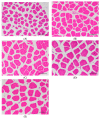Effects of Slaughter Age on Muscle Characteristics and Meat Quality Traits of Da-Heng Meat Type Birds
- PMID: 31906006
- PMCID: PMC7023096
- DOI: 10.3390/ani10010069
Effects of Slaughter Age on Muscle Characteristics and Meat Quality Traits of Da-Heng Meat Type Birds
Abstract
Due to the increasing demand for producing chickens with high meat quality, there is a need to determine its mode of action on chicken meat quality traits across a wider age spectrum. In this study, five groups of 200 male Da-Heng meat type birds were reared until slaughter age of 60, 90, 120, 150, 180 days old and breast muscle performance, meat quality traits, and myofiber characteristics were evaluated. The larger body weight and breast weight of chicken are based on larger myofiber diameter and area, less myofiber density for the older birds than younger birds. There was an age effect on all meat quality traits of chicken breast muscle (p < 0.05). Older chickens often presented a higher pH, lower drip loss, higher shear force, darker, and redder breast meat. The correlation coefficients showed that myofiber characteristics played an important role in breast pH values, drip loss, and meat color (p < 0.05). Besides, significant correlations were also found between meat quality traits (p < 0.05). Further studies are needed to explore the biochemical character and potential molecular mechanism of chicken breast muscle to determine the factors that causes these age-related differences in meat quality in the current study.
Keywords: chicken; meat quality; myofiber; slaughter age.
Conflict of interest statement
All authors have no declared conflict of interest.
Figures
Similar articles
-
Dietary Crude Protein and Lysine Levels Affect Meat Quality and Myofiber Characteristic of Slow-Growing Chicken.Animals (Basel). 2024 Jul 15;14(14):2068. doi: 10.3390/ani14142068. Animals (Basel). 2024. PMID: 39061530 Free PMC article.
-
Color values and other meat quality characteristics of breast muscles collected from 3 broiler genetic lines slaughtered at 2 ages.Poult Sci. 2011 Aug;90(8):1774-81. doi: 10.3382/ps.2010-01073. Poult Sci. 2011. PMID: 21753215
-
Variations in chicken breast meat quality: implications of struggle and muscle glycogen content at death.Br Poult Sci. 2005 Oct;46(5):572-9. doi: 10.1080/00071660500303099. Br Poult Sci. 2005. PMID: 16359110
-
The Role of Incubation Conditions on the Regulation of Muscle Development and Meat Quality in Poultry.Front Physiol. 2022 Jun 15;13:883134. doi: 10.3389/fphys.2022.883134. eCollection 2022. Front Physiol. 2022. PMID: 35784883 Free PMC article. Review.
-
Understanding the Determination of Meat Quality Using Biochemical Characteristics of the Muscle: Stress at Slaughter and Other Missing Keys.Foods. 2021 Jan 4;10(1):84. doi: 10.3390/foods10010084. Foods. 2021. PMID: 33406632 Free PMC article. Review.
Cited by
-
Data Mining as a Tool to Infer Chicken Carcass and Meat Cut Quality from Autochthonous Genotypes.Animals (Basel). 2022 Oct 8;12(19):2702. doi: 10.3390/ani12192702. Animals (Basel). 2022. PMID: 36230442 Free PMC article.
-
Proteomic Profiling of Thigh Meat at Different Ages of Chicken for Meat Quality and Development.Foods. 2023 Jul 30;12(15):2901. doi: 10.3390/foods12152901. Foods. 2023. PMID: 37569170 Free PMC article.
-
Influence of age at slaughter and sex on carcass characteristics, meat quality, fatty acids, and ribonucleotides in white-tailed yellow native chickens.Trop Anim Health Prod. 2024 Oct 2;56(8):313. doi: 10.1007/s11250-024-04121-9. Trop Anim Health Prod. 2024. PMID: 39356375
-
HPLC-QTRAP-MS-based metabolomics approach investigates the formation mechanisms of meat quality and flavor of Beijing You chicken.Food Chem X. 2022 Dec 21;17:100550. doi: 10.1016/j.fochx.2022.100550. eCollection 2023 Mar 30. Food Chem X. 2022. PMID: 36845483 Free PMC article.
-
Effects of marketable ages on meat quality through fiber characteristics in the goose.Poult Sci. 2021 Feb;100(2):728-737. doi: 10.1016/j.psj.2020.11.053. Epub 2020 Dec 1. Poult Sci. 2021. PMID: 33518126 Free PMC article.
References
-
- Zhang H., Wang J., Martin W. Factors affecting households’ meat purchase and future meat consumption changes in China: A demand system approach. J. Ethn. Foods. 2018;5:24–32. doi: 10.1016/j.jef.2017.12.004. - DOI
-
- Petracci M., Mudalal S., Soglia F., Cavani C. Meat quality in fast-growing broiler chickens. Worlds Poult. Sci. J. 2015;71:363–374. doi: 10.1017/S0043933915000367. - DOI
-
- Radaelli G., Piccirillo A., Birolo M., Bertotto D., Gratta F., Ballarin C., Vascellari M., Xiccato G., Trocino A. Effect of age on the occurrence of muscle fiber degeneration associated with myopathies in broiler chickens submitted to feed restriction. Poult. Sci. 2016;96:309–319. doi: 10.3382/ps/pew270. - DOI - PubMed
-
- Lorenzi M., Mudalal S., Cavani C., Petracci M. Incidence of white striping under commercial conditions in medium and heavy broiler chickens in Italy. J. Appl. Poult. Res. 2014;23:754–758. doi: 10.3382/japr.2014-00968. - DOI
Grants and funding
LinkOut - more resources
Full Text Sources


